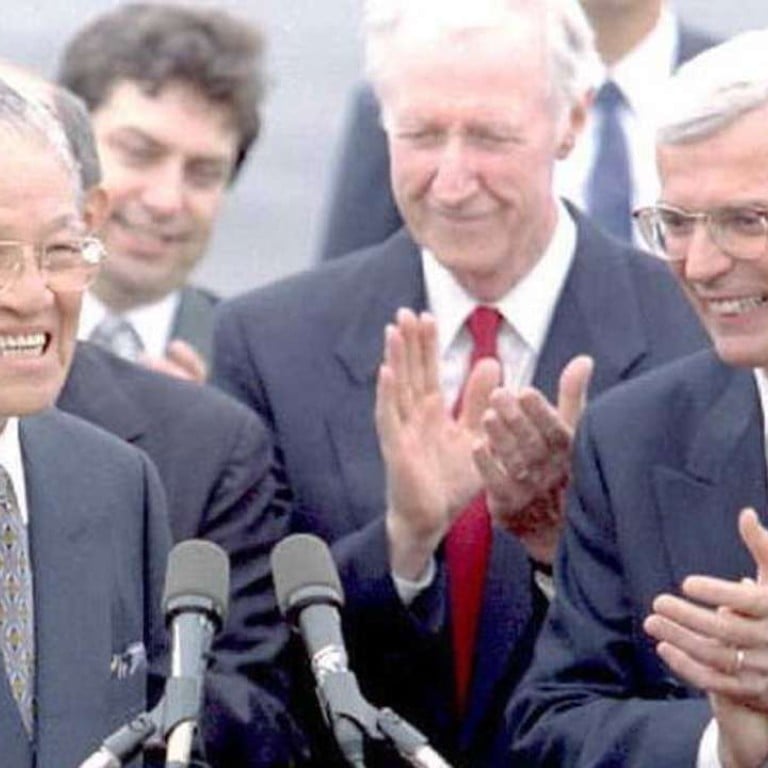
How a snub of the one-China policy almost led Beijing and US into war in the 1990s
Crisis sparked by Washington’s permission for Taiwan’s then leader Lee Teng-hui to make ‘private trip’ to US
The one-China policy, which maintains that Taiwan is part of China, has been the bedrock of Sino-US relations for four decades.
Beijing considers it has sovereignty over Taiwan, and that issues related to the island are part of its core interest. It has issued furious responses to any moves by the US that are regarded as supporting Taiwan’s independence, including selling weapons to the self-ruled island. Beijing has never given up on the idea of unifying Taiwan by force if necessary.
The two nations almost engaged in a military conflict in the Taiwan Strait between 1995 and 1996, which is known as the Third Taiwan Strait Crisis.
How did the crisis erupt?
During the crisis, Beijing carried out a series of the missile firings and combined military exercises near Taiwan, while Washington dispatched its largest size of combat forces to Asia since the Vietnam War, with two carrier battle groups – two aircraft carriers and its escort warships – to confront China.
The prelude to the crisis began in June 1995, when then-US president Bill Clinton granted Lee Teng-hui, Taiwan’s president at the time, a visa so he could make a “private trip” to accept an invitation to attend Cornell University’s alumni reunion.
It was the first visit to the US by the top leader of Taiwan since Washington had shifted its diplomatic recognition from the Taipei-based Republic of China (ROC) government to the Beijing-based People’s Republic of China (PRC) in 1979.

Beijing claimed Clinton’s decision had violated the one-China policy and threatened retaliation, including punishing US businesses in China, or offering nuclear cooperation with Iran.
On June 9, 1995, Lee gave a speech in English, titled, Always in My Heart, to the Cornell alumni on campus, during which he praised the island’s democratisation. He also used the phrase “the Republic of China on Taiwan”, when he said “ultimately, I know that the world will come to realise that the Republic of China on Taiwan is a friendly and capable partner for progress”.
This was seen by Beijing as shifting away from his own earlier position of “one China”, and moving towards independence.
In July, the People’s Liberation Army (PLA) carried out an eight-day “missile test”. The guided missiles landed 65km away from the Taiwan-held islet Pengchiayu, less than 160km north of Taipei. The PLA also conducted several amphibious assault exercises military exercises in Fujian province opposite the Strait, which lasted until late November.
In December the US government sent the US Navy aircraft carrier USS Nimitz and its Carrier Group Seven sailing through the strait. And the US Navy aircraft carrier USS Independence and its carrier group were also present in waters to the east of the Taiwan.
The presence of the US warships was considered a warning to mainland China against attacking Taiwan, while the US was accused of interfering in Chinese internal affairs by Beijing.
With the self-ruled island holding its first ever direct presidential election on March 23 1996, Beijing warned that voting for Lee would mean war. It began another set of missile tests and live-ammunition military exercises shortly before the election, which continued until two days after polling, when Lee was successfully re-elected.
How did the crisis end?
In March USS Nimitz and its escort warships sailed rapidly from the Persian Gulf, where they were taking part in military operation, and arrived in Taiwanese waters before the Taiwanese presidential election.
Beijing, having realised that it was unable to deal with the threat of the presence of the US Navy warships, finally softened its stance.
On March 28 then US defence secretary William Perry announced that the crisis was over.
The impact of the crisis
Beijing’s attempts to intimidate Taipei were ineffective and counterproductive. Rather than diminishing support for Taiwan’s then-president Lee, their efforts sparked more anger than fear, and seemed only to help solidify Lee’s support. He won the election with about 54 per cent of the vote supporting him.
The crisis also strengthened arguments about the need for further US arms sales to the island. Taiwan’s military ties with Japan also received a boost.
For Beijing, the crisis highlighted the shortcomings of its military power and the need to modernise and improve its military powers, especially those of its navy and air force.


